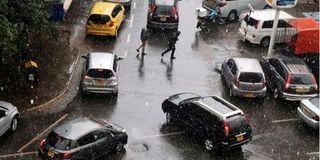Premium
Behold! The end of the cold is nigh, weatherman says

Kimathi Street in Nairobi on August 10, 2021. City dwellers braving the cold appeared caught unawares by the downpour.
What you need to know:
- The country has been at the heart of a cold season, with temperatures ranging from as low as 10 degrees Celsius to highs of 30.
- Meteorological Department says a drop in temperature is more pronounced in the central highlands of Kenya.
Transition from cold to warm weather is expected in most parts of the country next week, the Meteorological Department has said.
Since late June, the country has been at the heart of a cold season, with temperatures ranging from as low as 10 degrees Celsius to highs of 30.
And, just when everyone was bracing for “summer”, Nairobi and its environs woke up to unusually cold weather and cloudy skies yesterday. Even with some bit of sunshine in the afternoon, temperatures plunged again in some areas as evening approached.
Earlier, the weatherman had said temperatures would dip to as low as five degrees Celsius in the morning, and gradually rise to about 20 degrees Celsius as the day progressed.
According to Deputy Director of Kenya Meteorological department (KMD), Bernard Chanzu, the end of the cold season is approaching.
“It is known as a transition to a warmer season. The transition is marked by extreme cold temperatures. This is why the capital city and areas surrounding it are experiencing unusually low temperatures,” Mr Chanzu told the Saturday Nation.
He added that the country would not be out of the cold season until mid-August.
“There will be improvement by the end of next week,” Mr Chanzu said.
The Meteorological Department says cold seasons in Kenya usually begin from late June and last through to the beginning of August.
The department predicted patterns for the cold season.
Last Monday, again, it issued an update of daily temperature predictions for the week – till Sunday – or basically the whole transition period.
In a statement, the weatherman forecast that 10 counties, including Nairobi, would experience temperatures as low as five degrees Celsius.
As expected, Kenyans did not disappoint. They have come up with hilarious memes about the weather. #Nairobiwinter is trending on social media.
“The green city is the sun” – a phrase used to describe Nairobi in the past – has in the last few days changed to “the green city in the mist” or clouds as August becomes the new July.
“The weather is out with its relatives,” Betty Dindi tweeted.
Dr Pauline Kahumbu was not left behind.
Chilly weather
“Even the warmest duvet isn’t warm enough…time for a radical approach,” her tweet reads.
Some of the jokes on Twitter bear lessons on how to keep warm and the dos and don’ts to during the chilly weather.
One of the don’ts classifies taking a bath or shower as an extreme sport.
For its fleeting relevance online, the Bible verse Ecclesiastes 4:10 is heavily quoted.
It talks about two being better than one. It is, of course, a subtle way of getting at those who are single and “freezing”.
Some claim to be hiring out partners for the chilly season.
There is even a joke relating the cold to Kenya’s chronic curse of corruption.
It says unlike the tenderpreneurs known to supply air to the government, the one who won the tender to dispense cold was faithful, as the manifestation of the “goods” is palpable.
Maximum temperatures
Others asked whoever has the tender for blankets to quicken his steps and deliver.
Wired to see the sun every day, Kenyans seem to feel its absence, moreso in Nairobi where women and men are now wearing trench coats that are longer than their bathroom robes.
Some on social media relive how torturous waking up early has become.
Alarms are snoozed more than usual so people can cuddle their duvets a little longer, only to spend countless hours in traffic!
The weatherman says maximum temperatures recorded during the day this year have been cooler than usual.
Cold weather
However, the minimum temperatures – recorded at night – have been normal to above normal.
The Meteorological Department adds that the drop in temperature is more pronounced in the central highlands of Kenya, including Nairobi county, parts of the highlands west of the Rift Valley and the southeastern lowlands.
“The coldest temperature was experienced at Dagoretti station with an anomaly of -0.8 degrees Celsius, followed by Wilson station (-0.6 degrees Celsius),” the Kenya Meteorological Department said.
“The lowest minimum temperature was experienced at Embu station with an anomaly of -2.7 degrees Celsius, followed by Nyahururu (-1.3 degrees Celsius), Makindu (-0.5 degrees Celsius) and Kisii and Kericho (-0.2 degrees Celsius).”
The story of the cold weather begins in the southern hemisphere, which is experiencing winter as it is far away from the sun at this time of the year.
The southern hemisphere is the area of the Earth that is south of the Equator.
And we are experiencing the cold despite the World Meteorological Organisation (WMO) recording a new high of 18 degrees Celsius in the world’s coldest region – the Antarctica – which is in the southern hemisphere.
The organisation has cited climate change as a possible contributor.
There is high pressure because of the cold, blowing the wind towards the north.
Low temperatures
Kenya is in between the north and south hemispheres – at the equator – which is usually warmer.
An article published by Severe Weather Europe says despite cold air being common in the south, such strong weather going as far as Uruguay and Brazil in South America is unusual.
“We are receiving colder winds from the southern hemisphere. They are blowing across East Africa, leading to the current situation,” says Dr Richard Muita, the Assistant Director of Climate at the Meteorological Department.
“Normally, winds from the north and south meet around the equator. There is low pressure in the region, allowing it to converge.”
Dr Muita added that cloud cover can also explain the cold phenomenon.
“The kind cloud cover we are seeing overcasts even rainfall, preventing sunlight from reaching us. It stops heat from escaping to get to the earth surface,” he said
Scientists say unless studies are conducted to link Kenya’s low temperatures to climate change, other drivers can be used to explain the cold.
“Climate change is a permanent attribution. It could be a sign but we have to prove it,” Dr Muita said.
Additional reporting by Hellen Shikanda






